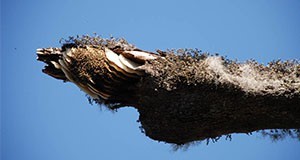Resumen
African honey bees entered the United States in the early 1990s and have since spread throughout the Southwest and Southeast, including parts of Florida. Compared to European bees, African bees are highly aggressive when disturbed and are more likely to sting humans and animals. This revised 6-page fact sheet covers the history and distribution of African honey bees in the Americas and explains how beekeepers and residents can manage their interactions with these bees. Written by H. Glenn Hall, Catherine Zettel-Nalen, and James D. Ellis, and published by the UF Department of Entomology and Nematology, December 2014.
Citas
Anonymous. 1972. "Final Report of the Committee on the African Honey Bee". Washington, D.C.: Natl. Res. Counc. Natl. Acad. Sci. 95 pp.
Anonymous. 1986. Proceedings of Africanized Honey Bee Symposium in Atlanta, GA. The American Farm Bureau Research Foundation. Park Ridge, IL.
Gary, N. E, H. Daly, S. Locke and M. Race. 1985. "The Africanized Honey Bee: Ahead of Schedule." California Agriculture, November-December, pp 4-7.
Hall, H. G. 1992. DNA Studies Reveal Processes Involved in the Spread of New World African Honeybees. Florida Entomologist 75: 51-59. https://doi.org/10.2307/3495480
Hall, H. G. 1992. Suspected African honeybee colonies in Florida tested for identifying DNA markers. Florida Entomologist 75: 257-266. https://doi.org/10.2307/3495628
Harrison, J. F. and Hall, H. G. 1993. African-European honeybee hybrids have low non-intermediate metabolic capacities. Nature 363: 258-260. https://doi.org/10.1038/363258a0
McDowell, R. 1984. The Africanized Honey Bee in the United States: What Will Happen to the U.S. Beekeeping Industry? Agric. Econ. Rep. No. 519. Washington, D.C., U.S. Govt. Printing Office. 33 pp.
Taylor, O. 1985. African Bees: Potential Impact in the United States. Bulletin of Entomological Society of America. Winter, 1985, pp. 15-24. https://doi.org/10.1093/besa/31.4.15
Sheppard W.S. 1989a A history of the introduction of honey bee races into the United States: Part I. Am. Bee J
Sheppard W.S. 1989b A history of the introduction of honey bee races into the United States: Part II. Am. Bee J.
Spivak, M., D. Fletcher and M. Breed, eds. 1991. The 'African' Honey Bee. San Francisco, CA: Westview Press. 435 pp.

